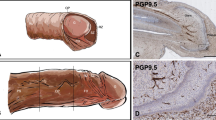Abstract
Sensory innervation of the skin influences wound healing through the release of neuropeptides from the nerve endings. The purpose of this study was to investigate the differences in the sensory innervation of the normal and the hypospadiac prepuce. The prepuce from 10 healthy children undergoing routine circumcision and 10 age-matched children undergoing hypospadias repair were submitted for immunohistochemistry, using antibodies against protein gene product (PGP) 9.5, calcitonin gene-related peptide (CGRP), and substance P (SP). The hypospadiac prepuce was found to be hypo-innervated for PGP 9.5 and CGRP positive nerves when compared with the normal prepuce (p<0.05). The number of SP-positive nerves were increased in the hypospadiac prepuce, but not to statistical significance (p=0.06, confidence interval >95%). There may be differences in the sensory innervation of the normal and hypospadiac prepuce. These differences in tissue environment may partly explain the postoperative edema, poor wound healing leading to urethrocutaneous fistula (UF), and increased analgesia requirements in patients undergoing hypospadias surgery.




Similar content being viewed by others
References
Engin C, Demirkan F, Ayhan S, Atabay K, Baran NK (1996) Delayed effects of denervation on wound contraction in rat skin. Plast Reconstr Surg 98:1063–1067
Richards AM, Floyd DC, Terenghi G, McGrouther DA (1999) Cellular changes in denervated tissue during wound healing in a rat model. Br J Dermatol 137:1093–1099
Misery L (1997) Skin immunity and the nervous system. Br J Dermatol 137:843–850
Wallengren J, Chen D, Sundler F (1999) Neuropeptide containing C-fibers and wound healing in rat skin: neither capsaicin nor peripheral neurectomy affects the rate of healing. Br J Dermatol 140:400–408
Reilly DM, Ferdinando D, Johnston C, Buchanan KD, Green MR (1997) The epidermal nerve fibre network: characterization of nerve fibers in human skin by confocal microscopy and assessment of racial variations. Br J Dermatol 137:163–170
Kahler CM, Bellmann R, Reinisch N, Schratzberger P, Gruber B, Wiedermnn CJ (1996) Stimulation of human skin fibroblast migration by neuropeptide secretoneurin. Eur J Pharmacol 304:135–139
Severini C, Improta G, Falconieri-Erspamer G, Salvadori S, Erspamer V (2002) The tachykinin peptide family. Pharmacol Rev 54:285–322
Lai X, Wang Z, Wei L, Wang L (2002) Effect of substance P released from peripheral nerve ending on endogenous expression of epidermal growth factor and its receptor in wound healing. Chin J Traumatol 5:176–179
Snodgrass WT, Mitchell ME (2002) Long-term follow up of hypospadias repair. Lesson 34, AUA updates series XXI, pp 266–271
Teague J, Roth D, Gonzales E (1994) Repair of hypospadias—complications using meatal-based flap urethroplasty. J Urol 151:470–472
Waterman B, Renschler T, Cartwright P, Snow BW, deVries CR (2002) Variables in successful repair of urethrocutaneous fistula after hypospadias repair. J Urol 168:726–730
El-Galley R, Smith E, Cohen C, Petros JA, Woodard J, Galloway NTM (1997) Epidermal growth factor(EGF) and EGF receptor in hypospadias. Br J Urol 79:116–119
Baskin LS, Lee YT, Gunha GR (1997) Neuroanatomical ontogeny of the human penis. Br J Urol 79:628–640
Baskin LS, Erol A, Li YW, Cunha GR (1998) Anatomical studies of hypospadias. J Urol 160:1108–1115
Senapati A, Anad P, McGrogor GP (1986) Depletion of neuropeptide during wound healing in rat skin. Neurosci Lett 71:101
Onuoha GN (2001) Level of vasodilators (SP, CGRP) and vasoconstrictors (NPY) peptide in early human burns. Eur J Clin Invest 31:253–257
Onuoha GN (2001) Circulatory sensory peptide levels within 24 hours of human bone fracture. Peptides 22:1107–1110
Sawynok J (2003) Topical and peripherally acting analgesics. Pharmacol Rev 55:1–20
Gunter JB, Forestner JE, Manley CB (1990) Caudal epidural anesthesia reduces blood loss during hypospadias. J Urol 144:517–519
Szallasi A, Blumberg PM (1999) Vanilloid (capsaicin) receptors and mechanism. Pharmacol Rev 51:159–211
Gherardini G, Gurlek A, Evans GRD (1998) Venous ulcers: improved healing by iontophoretic administration of calcitonin gene-related peptides and vasoactive intestinal polypeptides. Plast Reconstr Surg 101:90–93
Engin C (1998) Effects of calcitonin gene-related peptides on wound contraction in denervated and normal rat skin: a preliminary report. Plast Reconstr Surg 101:1887–1890
Gherardini G, Lundeberg T, Cui JG, et al. (1999) Spinal cord stimulation improves survival in ischemic skin flaps: an experimental study of possible mediation by calcitonin gene-related peptide. Plast Reconstr Surg 103:1221–1228
Author information
Authors and Affiliations
Corresponding author
Rights and permissions
About this article
Cite this article
Nazir, Z., Masood, R. & Rehman, R. Sensory innervation of normal and hypospadiac prepuce: possible implications in hypospadiology. Ped Surgery Int 20, 623–627 (2004). https://doi.org/10.1007/s00383-004-1244-1
Accepted:
Published:
Issue Date:
DOI: https://doi.org/10.1007/s00383-004-1244-1




